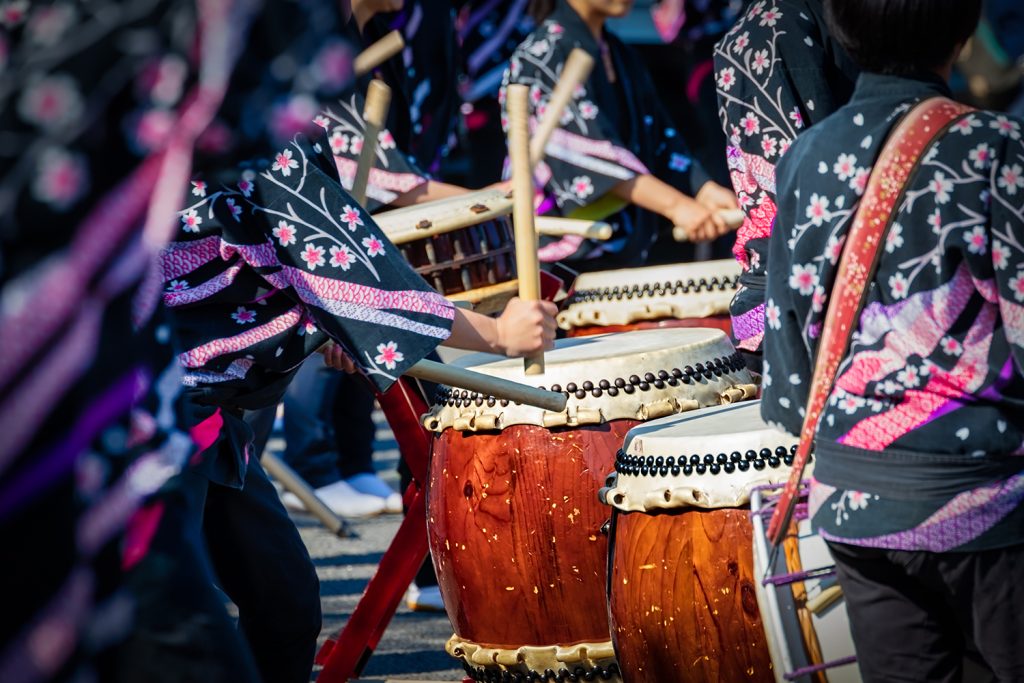When one thinks of Japan, images of vibrant festivals, ancient traditions, and mesmerising cultural performances often come to mind. At the centre of this captivating tapestry lies an art form that embodies the spirit and soul of the nation: taiko drumming. For tourists planning to visit Japan, delving into the world of taiko offers a profound glimpse into the country’s rich heritage and deep-rooted cultural significance.
Background and History
Taiko, which translates to “drum” in Japanese, refers to a style of percussion music that utilises large drums of various sizes and shapes. While the origins of taiko can be traced back to ancient times, its modern incarnation evolved over centuries, influenced by a myriad of cultural and historical factors.
The earliest evidence of taiko dates back to Japan’s Jomon period (10,000–300 BCE), where drums were used in religious ceremonies and rituals. However, it was during the Nara period (710–794 CE) that taiko began to take on a more structured form, with the introduction of court music and the emergence of ceremonial drumming ensembles.
Throughout Japan’s feudal era, taiko played a multifaceted role in society. Samurai warriors utilised taiko drums on the battlefield to boost morale and communicate commands, while village communities employed them during agricultural rituals and celebrations. Over time, taiko became deeply intertwined with various aspects of Japanese life, from religious ceremonies and festivals to theatrical performances and martial arts training.
The modern resurgence of taiko can be attributed to the efforts of visionary individuals such as Daihachi Oguchi, who founded the Osuwa Daiko group in the 1950s, and Seiichi Tanaka, who established the San Francisco Taiko Dojo in the 1960s. These pioneers sought to revitalise the art form and introduce it to a global audience, leading to the widespread popularity of taiko both in Japan and abroad.
Ingrained in Japanese Culture
Taiko drumming is more than just a musical art form; it is a cultural phenomenon that resonates deeply with the Japanese people. Its rhythmic beats and thunderous vibrations evoke a sense of unity, energy, and vitality, mirroring the pulse of life itself.
In Japanese society, taiko is prominently featured in various traditional festivals and ceremonies, serving as a symbol of community cohesion and spiritual reverence. During Shinto rituals, taiko drums are used to summon the gods and purify the sacred space, while at local matsuri (festivals), taiko performances ignite the atmosphere with their dynamic rhythms and electrifying energy.
Moreover, taiko holds a special place in Japanese performing arts, often serving as the rhythmic backbone of traditional theatrical forms such as Noh, Kabuki, and Bunraku. In these contexts, taiko drumming enhances the emotional intensity of the storytelling, heightening the drama and drawing the audience into the narrative.
Beyond its cultural significance, taiko has also become a source of pride and identity for many Japanese people. Across the country, taiko groups, known as taiko ensembles or kumi-daiko, have emerged, bringing together individuals of all ages and backgrounds to share in the joy of drumming. These community-based groups not only preserve traditional repertoire but also innovate and experiment with new styles, pushing the boundaries of the art form while honouring its heritage.
For tourists visiting Japan, experiencing taiko firsthand offers a unique opportunity to connect with the country’s cultural heritage on a profound level. Whether attending a live performance, participating in a taiko workshop, or witnessing a taiko procession at a local festival, immersing oneself in the rhythmic world of taiko is sure to leave a lasting impression.
Conclusion
Taiko drumming stands as a powerful testament to Japan’s rich cultural legacy and enduring spirit. From its ancient origins to its modern resurgence, taiko has woven itself into the fabric of Japanese society, serving as a beacon of unity, vitality, and artistic expression. For tourists seeking to explore the heart and soul of Japan, embarking on a journey into the world of taiko promises an unforgettable experience filled with rhythm, energy, and cultural immersion.











